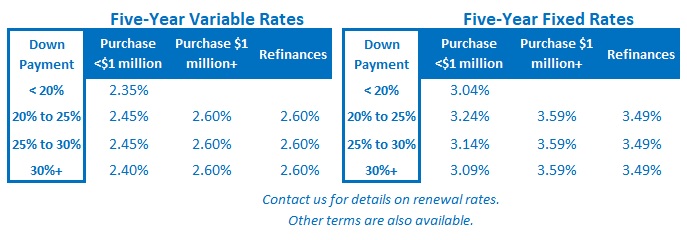The Bank of Canada Gets Reacquainted with Murphy’s Law
June 25, 2018Thoughts on the Bank of Canada’s Meeting This Week
July 9, 2018 In its most recent policy statement released on May 30, the Bank of Canada (BoC) gave every indication that it would raise its overnight rate, which our variable mortgage rates are priced on, at its next meeting on July 11. But right afterwards, U.S. President Trump started a trade war with Canada (among other countries), and we were hit with a steady string of mostly weaker-than-expected economic data.
In its most recent policy statement released on May 30, the Bank of Canada (BoC) gave every indication that it would raise its overnight rate, which our variable mortgage rates are priced on, at its next meeting on July 11. But right afterwards, U.S. President Trump started a trade war with Canada (among other countries), and we were hit with a steady string of mostly weaker-than-expected economic data.
These events fueled speculation that the BoC might not actually follow through with a rate-hike next week and piqued everybody’s interest in BoC Governor Poloz’s speech to the Greater Victoria Chamber of Commerce, which he delivered last Wednesday. Market watchers expected Governor Poloz to use this forum to confirm whether recent events had changed the Bank’s near-term plans.
Governor Poloz began his speech by chronicling the evolution of transparency in Canadian central banking and extolling the benefits that it has brought to our economy. But then he made the case that forward guidance, a key recent element of that transparency, had actually diminished the Bank’s effectiveness, and he explained why the BoC wants to phase it out altogether.
This was a somewhat surprising acknowledgement and one that seemed more significant than whether or not the Bank will move its policy rate at its next meeting (which I’ll get to in a minute).
Here are the highlights from Governor Poloz’s speech:
- The BoC’s communication policy has become increasingly transparent over many decades because it believes that transparency goes hand-in-hand with trust, and by association, stability. Examples of significant BoC communication milestones along the way include the introduction of inflation targeting, the regular issuance of the Bank’s Monetary Policy and Financial System Review reports, and the practice of using fixed dates for the announcement of interest-rate decisions.
- This transparency helped to reduce financial-market volatility when our economy experienced negative shocks. Governor Poloz highlighted the financial crisis of 2008 and the oil-price collapse in late 2014 as examples of where the BoC’s guidance helped to alleviate market uncertainty.
- After the financial crisis of 2008, many central banks cut their policy rates to 0% and then turned to new and unconventional policies to stimulate their economies. One such policy is “forward guidance”, which ties policy-rate movements to “an explicit condition, such as a specific time frame or an economic statistic”. (Some examples would be ‘rates won’t rise until the fourth quarter of next year’ or ‘rates won’t rise until inflation returns to 2%’.) In 2009, the BoC used forward guidance when it said that the overnight rate would remain at 0% “for an extended period, provided that the outlook for inflation remained unchanged”. That reassurance provided additional economic stimulus because it caused longer-term interest rates, which the BoC does not control directly, to decline.
- Forward guidance “makes it easier for financial market participants to predict the actions of the central bank”, but the BoC views it “as an unconventional policy tool, to be deployed only in extraordinary times”. Its concern is that forward guidance “reduces the reaction of markets to economic news”.
- Forward guidance can also lead market participants to believe that there is more certainty than actually exists. Governor Poloz highlighted 2013 as an example of where the Bank “could not fully explain why exports and business investment were weaker than our economic models were projecting. We wanted markets to appreciate the uncertainty we were facing, and were concerned that providing forward guidance was giving participants a false sense of certainty”. The BoC decided that its best way forward was to shift its uncertainty “back out into the marketplace”.
This decision to phase out forward guidance marks a significant shift for market participants, including variable-rate mortgage borrowers, who had become accustomed to more explicit policy-rate commentary. The BoC now believes that more uncertainty about its future plans will enhance both its credibility and its ability to impact markets at key inflection points in the economic cycle.
Now let’s circle back to the question that everyone tuned into the speech to have answered. It appears that recent events have not altered the BoC’s near-term rate-hike plan. Governor Poloz made this clear when he said:
- “Our latest interest rate announcement at the end of May is a case in point. Some observers noted that instead of repeating that we would be cautious about future policy adjustments, we said that we would take a gradual approach to raising interest rates. In fact, this shift in language represented increased confidence that the economy was performing as we expected, and that higher interest rates will indeed be warranted. Financial markets understood our message.” Translation: That message hasn’t changed. We’re still planning to raise.
The Bottom Line: BoC Governor Poloz essentially confirmed that the Bank will raise its policy rate when it meets next week. That said, I continue to believe that repeated policy-rate increases over the short term are unlikely. My view is largely based on Governor Poloz’s acknowledgement of the BoC’s heightened uncertainty surrounding trade negotiations, the ongoing effects of recently enacted mortgage rule changes, and the impact that today’s elevated debt levels will have on our economy’s sensitivity to interest-rate changes.
We should also take a moment to appreciate the clarity that Governor Poloz offered about the BoC’s near-term rate-hike plans because his latest speech confirmed that he’ll be offering less of it going forward.








